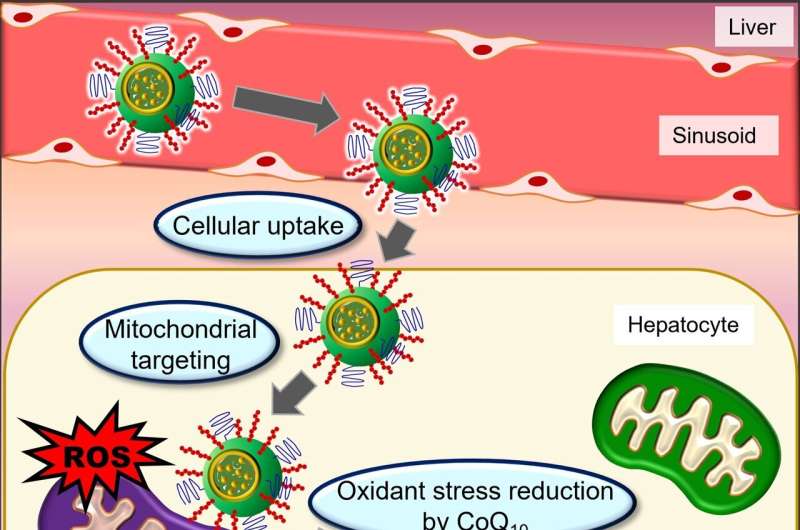This article has been reviewed according to Science X's editorial process and policies. Editors have highlighted the following attributes while ensuring the content's credibility:
fact-checked
peer-reviewed publication
trusted source
proofread
New method for delivering an antioxidant directly to mitochondria in the liver, mitigating oxidative stress

Mitochondria are microscopic organelles found within cells, and are by far the largest producer of the molecule adenosine triphosphate (ATP), which provides energy to many processes in living cells. The process by which mitochondria synthesize ATP generates a large amount of reactive oxygen species (ROS), chemical groups that are highly reactive.
In a healthy cell, the ROS are controlled by the mitochondria; however, when this balance is lost, the excess ROS damages the mitochondria and subsequently cells and tissues. This phenomenon, known as oxidative stress, can cause premature aging and disease. The ROS that cause oxidative stress can be controlled by antioxidants.
A research team led by Professor Yuma Yamada, Distinguished Professor Hideyoshi Harashima and Assistant Professor Mitsue Hibino at Hokkaido University have developed a system to deliver antioxidants to mitochondria to mitigate the effects of excess ROS. Their findings have been published in Scientific Reports.
"We previously developed a drug delivery system which we named CoQ10-MITO-Porter," explained Hibino. "This system consists of the antioxidant molecule Coenzyme Q10 (CoQ10)—which is also required by mitochondria for ATP production—encapsulated by a lipid nanoparticle that would target mitochondria. In this study, we aimed to test if this system could work in living organisms."

Variations of the formula for the synthesis of CoQ10-MITO-Porter were tested, and their structures were examined with electron microscopy. CoQ10-MITO-Porter was administered to mice models with acetaminophen-induced liver damage. Acetaminophen overdoses cause excess ROS in mitochondria, which in turn damages cells in the liver. CoQ10-MITO-Porter was transported primarily to the liver and measurably reduced the damage caused by ROS. A further discovery was that downsized CoQ10-MITO-Porter particles with more efficient packaging of CoQ10 were more effective at treating liver damage than the original formulation.
"Our study has shown that the MITO-Porter system we developed can be used to deliver CoQ10 to the liver, making it an important therapeutic strategy against conditions that cause oxidative stress," concluded Yamada. "Our future work will focus on elucidating the mechanism responsible for the therapeutic effect of CoQ10."
More information: Mitsue Hibino et al, A System that Delivers an Antioxidant to Mitochondria for the treatment of Drug-Induced Liver Injury, Scientific Reports (2023). DOI: 10.1038/s41598-023-33893-7. www.nature.com/articles/s41598-023-33893-7
Journal information: Scientific Reports
Provided by Hokkaido University




















